Stuart Jeanne Bramhall's Blog: The Most Revolutionary Act , page 373
September 1, 2023
Big Pharma excels in creating customers for life

Health Advisory and Recovery Team
For those of us who started pulling uncomfortable threads of ‘hang on a minute, that doesn’t seem quite right’ and kept going, the world is now a strange landscape. When it comes to our health, many of us have had life-long assumptions smashed to smithereens.
The last few years have been a brutal introduction to the harsh realities of the medical industrial complex. Its recent behaviour has completely shattered public trust. Overnight, medical ethics including bodily autonomy and informed consent were tossed out. The dying were unable to see loved ones, blanket DNRs were applied and people were subjected to forced procedures (e.g. PCR testing) or were discriminated against based on their covid vaccination status. Most went along with these inhumane diktats that came from ‘on high’. Is it any wonder that many people would now be reluctant to enter a hospital even where there was a genuine need? There has to be a balance where people regain the confidence to seek care if genuinely needed. Throwing the baby out with the bath water will not lead to fewer excess deaths. Patients rightly want the best available care but in the current system of protocolised medicine, that pathway is far from guaranteed.
What is striking, when spending time amongst those still firmly planted behind the Overton window, is the notion that for any ailment – particularly with advancing age – the answer is always pharmaceutical or surgical interventions rather than lifestyle changes. This is clearly superb for Big Pharma. Less certain, is the benefit for the end user. Blanket approvals of the novel, mRNA injections across all age groups – in spite of total lack of long-term safety data – showed us clearly, in real-time, how money and politics corrupts health regulators. This renders the current system totally defunct. This article in The Epoch Times reports how 65% of drug recommendations by the FDA are approved based on a single study. In the meantime doctors who want to promote lifestyle changes as first line treatment ahead of more dangerous interventions, find themselves increasingly working in a system opposed to them.
Trying to make an informed assessment of risks and benefits becomes almost impossible, once you realise how untrustworthy scientific literature has become. Or perhaps always was. ‘But it says so in the Lancet….’ Hopefully, many have now realised how empty this sentence sounds. Research outcomes are heavily influenced by the desires of those funding them, who just happen to be the ones manufacturing the drugs. This meme, whilst humorous, is worryingly accurate:
From statins to HRT, to proven-to-be-ineffective surgeries, to antidepressants, there is almost zero discussion in modern ‘medicine’ of preventative measures that do not benefit Big Pharma. Diet, exercise, breathing techniques, stress management, ensuring proper balance of micronutrients, enquiring about emotional and relationship causes of ill health. These should be the basic lines of enquiry for any competent physician, long before offering various magic bullets following the luxurious seven minute consultation via Zoom. GPs offering this paltry level of service are complicit in ensuring their own redundancy within a few short years. AI would serve just as well, the human factor having been almost entirely scrubbed out.
Most people with elderly parents know that they often need special plastic containers to house the numerous medications that they take on a daily basis. Often many of these drugs were added in sequence to deal with side effects (or more correctly, ‘effects’) of the medications that were introduced first. This close-to-the-bone satire that has been circulating online really sums it up:
“I took ASPIRIN for the headache caused by the ZYRTEC
for the hay fever I got from the RELENZA
for the upset stomach and flu-like symptoms caused by the VIAGRA
for the erectile dysfunction from the PROPECIA
for the hair loss caused by the RITALIN
for my short attention span caused by the SCOPODERM TTS
for the motion sickness that I got from the LOMOTIL
for the diarrhoea caused by the XENICAL
for the weight gain caused by the PAXIL
for the anxiety that I got from the ZOCOR
that I’m taking for my high cholesterol, because a good diet and exercise is just too much trouble.”
There seems to be the prevailing belief that human beings can only stay alive with constant interference from the medical profession. But what if the entire system keeps you sick, in order to retain you as a loyal customer to The Firm? What if much of the so-called ‘safety’ data are in fact just as flawed as those used to push the covid ‘vaccines’ in 2020? For those of us who became curious (suspicious?), we felt it might be worth having a retrospective look at other trends in medical diagnostics and treatments.
As it turns out, the more you look, the more you find…
Doing more harm than good?A deep dive into questionable drugs and surgical practices that are built into standard protocols here in the UK would fill a book. Maybe several books. That is beyond the scope of this article, however here are a few ‘top picks’ to get started:
Statins: This has been allowed on occasion to seep into mainstream consciousness, but it is still worth reading the book written by Dr Malcolm Kendrick, entitled The Great Cholesterol Con. There is simply no good evidence for the widespread use of statins. The notion that they don’t have harmful effects is also nonsense. A 17-year study on the elderly showed that low serum cholesterol was associated with increased frailty, accelerated mental decline, and early death. This should get any sensible clinician asking questions about what effects deliberately lowering it might have on long-term health. During ward rounds one senior consultant says to his juniors, ‘let’s stop this wonder drug’, scoring it off the prescription list. The juniors ask why he calls it that, to which he replies ‘I wonder what use it is!’SSRIs: a growing number of studies show they are less effective than thought. Has this resulted in a decline in prescriptions? Of course not. In fact psychiatry in general is an area that many medics describe as barbaric. The links between gut and brain health are now widely accepted and yet almost no money goes into mainstream R&D in this area. Cures are simply not as profitable as life-long customers.HRT: There is evidence for an increased risk of blood clots and stroke as well as an increased risk of breast and ovarian cancer in women using HRT. In researching this article and questioning women who had recently started on these drugs, most had not been adequately informed as to any associated risks. Many had no idea what kind of HRT they were even taking. This shows the level of blind faith people still have in a system that, judging by the history of criminal fines paid out, does not have a very good track record, to say the least.Angioplasty: For decades, we were led to believe that angioplasties are an effective treatment for not only angina (chest pain) but also served as protection from a heart attack. Now, the evidence seems to point to the procedure being ‘useless’ or even worse than useless. Lifestyle and diet changes are more effective and have the capacity to reverse the progression of coronary heart disease. This hardly seems like rocket science but somehow has taken decades to ‘realise’.Childhood Vaccinations: or as we like to call them, The Sacred Cows. Daring to even utter the words that these interventions may carry risks as well as benefits, or pointing out that there are no long-term safety studies using a genuine placebo, seems to create an allergic reaction in even the most sceptical of folks. However, at HART the adage ‘everything is back on the table’ is one we hold dear. Many people who now have the appetite to question The Science are quietly murmuring the name of the book Turtles All the Way Down. Perhaps it is worth reading, just to know what the alternative view point is. We do not need protection from theories. We need them to be aired and debated, so we can reach full and informed decisions. No topic should be out of bounds, including this one. Perhaps especially this one.
are quietly murmuring the name of the book Turtles All the Way Down. Perhaps it is worth reading, just to know what the alternative view point is. We do not need protection from theories. We need them to be aired and debated, so we can reach full and informed decisions. No topic should be out of bounds, including this one. Perhaps especially this one.This list could go on ad infinitum, but instead we will end with a list of suggestions given by various practising medics when asked about drugs or interventions that they question. Once again, we point out that people are individuals. Protocols are not good for individuals. Do your research, take responsibility and remember that The Experts may have their hands tied firmly behind their back by The Money.
List of drugs with questionable efficacy/safety from currently prescribing doctors: Dementia drugs: noted poor efficacy, serious side-effects;Anticoagulants: should be used more judiciously due to risks of bleeds after falls;Bisphosphonates: this drug for osteoporosis has notoriously bad side effects, and shows questionable efficacy;Benzodiazepines and other so-called ‘Z’ drugs (zopiclone, eszopiclone, zaleplon and zolpidem): habit forming with evidence of severe side effects such as dementia, infections, respiratory disease exacerbation, pancreatitis, and cancer. They cause severe withdrawal symptoms;Gliflozins: the new ‘wonder drugs’ used in diabetes and heart failure. Concerns about kidney damage and they come with no long-term safety profile;GLP-1 agonist injectables: originally marketed for diabetes, now being sold as weight loss drugs. Concerns over risks of thyroid and pancreatic cancer and can cause pancreatitis;Psychiatric drugs in general. Recommended reading: Toxic Psychiatry by Peter Breggin;Antivirals: For example Tamiflu, which is now labelled a ‘fiasco’. The drug caused severe side effects such as hallucinations, self-injury, abnormal behaviour and renal impairment;Proton Pump Inhibitors (PPIs): evidence of major side effects with long-term use, including dementia, chronic kidney disease and increased cancer risk;Beta Blockers: evidence that long-term use is not associated with improved cardiovascular outcomes, with considerable side effects, such as depression and fatigue;Anti-arthritis drugs: Overuse of NSAIDs in particular can cause bleeding, heart attack, stroke, and renal damage.[…]
August 31, 2023
Sen. Ron Johnson accuses CDC of ‘censorship’ of own COVID vaccine information

By Ryan King
New York Post
Sen. Ron Johnson (R-Wis.) has accused the Centers for Disease Control and Prevention of coordinating with social media companies to suppress certain information about COVID-19 vaccines.
Citing one of his own social media posts about vaccines that got labeled misleading, Johnson claimed the agency had abused its authority and demanded it fork over key documents about the efforts in a Monday letter to CDC Director Dr. Mandy Cohen.
“Based on recent information I have received … it is clear that CDC abused its authority by engaging in a censorship campaign to suppress and discredit certain viewpoints it labeled as ‘misinformation,’” Johnson wrote in the letter, obtained by The Post.
As an example, Johnson highlighted a Jan. 3, 2022, post he made on Twitter, now known as X, that highlighted information from the CDC’s Vaccine Adverse Event Reporting System (VAERS).
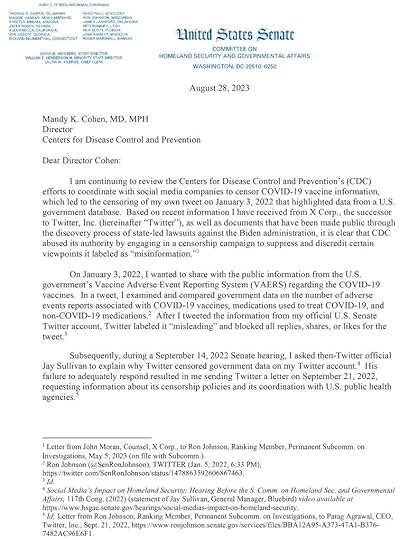 The Wisconsin senator admonished the CDC’s push for social media content moderation regarding the COVID-19 vaccines.Senator Ron Johnson
The Wisconsin senator admonished the CDC’s push for social media content moderation regarding the COVID-19 vaccines.Senator Ron Johnson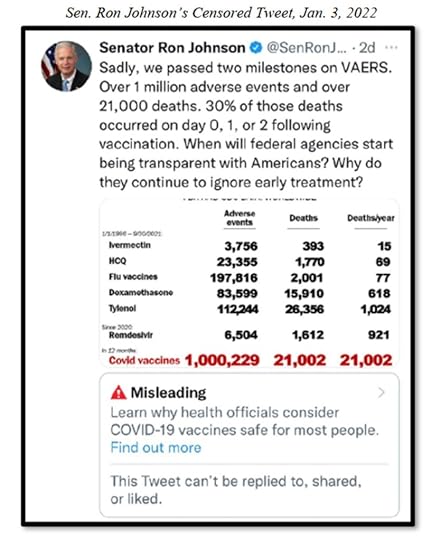 The post that got Sen. Ron Johnson slapped with a misleading label on X, the platform formerly known as Twitter.Senator Ron Johnson
The post that got Sen. Ron Johnson slapped with a misleading label on X, the platform formerly known as Twitter.Senator Ron JohnsonIn the post, Johnson claimed that VAERS data showed there had been over 1 million adverse effects from the COVID-19 jab. That post was labeled misleading on the platform with a note explaining that most public health officials had deemed the vaccines safe.
All replies, shares, or likes stemming from that post were then blocked by the platform, according to Johnson. Since then, X has switched to a “Community Notes” system that crowdsources corrections to potentially misleading posts.
The platform’s new leadership later explained to Johnson that executive branch officials, particularly from the CDC, “communicated with social media companies, including Twitter, about ‘COVID Vaccine Misinformation,’” the senator wrote.
“The information Twitter provided showed a clear and concerted effort by the CDC to censor those who tweeted about VAERS data,” Johnson added.
Johnson, the ranking member on the Senate’s Permanent Subcommittee on Investigations, is demanding records detailing interactions between all CDC employees and employees at X, Facebook, and YouTube regarding 10 individuals who expressed vaccine and lockdown-skeptical views beginning Dec. 1, 2019.
Those 10 include Johnson himself, Brianne Dressen, John Ioannidis, Robert Kennedy, Jr., Pierre Kory, Theresa Long, Robert Malone, Peter McCullough, Harvey Risch, and Aaron Siri.
The Wisconsin senator is also requesting all records pertaining to CDC interactions with both private sector companies and federal agencies about suppression of online speech or COVID-19 misinformation policies.
He is also seeking records about “Be On the Lookout” topics and a list of all social media posts the CDC flagged as “containing misinformation, disinformation, or generally disfavored speech.”
Johnson gave the CDC a Sept. 11 deadline to comply. The agency did not return The Post’s request for comment, but has noted in the past that VAERS relies on reports submitted by individuals rather than health officials.
“VAERS is not designed to determine if a vaccine caused a health problem but is especially useful for detecting unusual or unexpected patterns of adverse event reporting that might indicate a possible safety problem with a vaccine,” read an advisory to the social network included in Johnson’s letter.
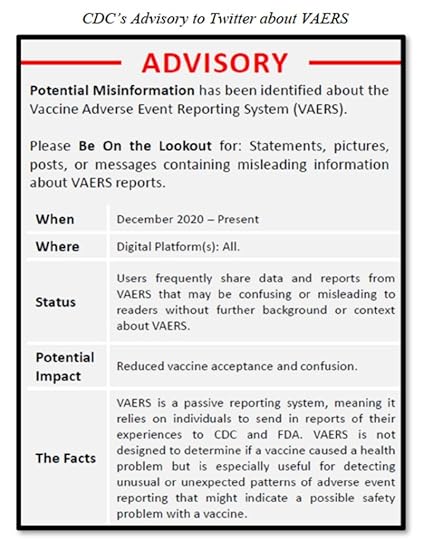 The Senator noted a CDC advisory to the platform about misinformation and what to be on the lookout for on social media.Senator Ron Johnson
The Senator noted a CDC advisory to the platform about misinformation and what to be on the lookout for on social media.Senator Ron JohnsonIn the letter, Johnson also laid out a timeline laying out the sequence of events in the run-up to his tweet about VAERS.
“It appears that CDC’s efforts to coordinate with Twitter to discredit posts about VAERS shortly followed my own public statements about VAERS data and the mainstream media’s condemnation of my remarks,” he wrote.
Content moderation policies on social media platforms have long been a rallying cry for conservatives who complain they have been unfairly censored.
In the House, Republicans led by Subcommittee on Government Weaponization Chairman Jim Jordan (R-Ohio) have been probing social media policies.
[…]
Via https://nypost.com/2023/08/30/sen-johnson-lambasts-cdc-demands-docs-on-censorship-of-vaccine-data/
Sen. Ron Johnson accuses CDC of ‘censorship’ of own COVID vaccine inf

By Ryan King
New York Post
Sen. Ron Johnson (R-Wis.) has accused the Centers for Disease Control and Prevention of coordinating with social media companies to suppress certain information about COVID-19 vaccines.
Citing one of his own social media posts about vaccines that got labeled misleading, Johnson claimed the agency had abused its authority and demanded it fork over key documents about the efforts in a Monday letter to CDC Director Dr. Mandy Cohen.
“Based on recent information I have received … it is clear that CDC abused its authority by engaging in a censorship campaign to suppress and discredit certain viewpoints it labeled as ‘misinformation,’” Johnson wrote in the letter, obtained by The Post.
As an example, Johnson highlighted a Jan. 3, 2022, post he made on Twitter, now known as X, that highlighted information from the CDC’s Vaccine Adverse Event Reporting System (VAERS).
 The Wisconsin senator admonished the CDC’s push for social media content moderation regarding the COVID-19 vaccines.Senator Ron Johnson
The Wisconsin senator admonished the CDC’s push for social media content moderation regarding the COVID-19 vaccines.Senator Ron Johnson The post that got Sen. Ron Johnson slapped with a misleading label on X, the platform formerly known as Twitter.Senator Ron Johnson
The post that got Sen. Ron Johnson slapped with a misleading label on X, the platform formerly known as Twitter.Senator Ron JohnsonIn the post, Johnson claimed that VAERS data showed there had been over 1 million adverse effects from the COVID-19 jab. That post was labeled misleading on the platform with a note explaining that most public health officials had deemed the vaccines safe.
All replies, shares, or likes stemming from that post were then blocked by the platform, according to Johnson. Since then, X has switched to a “Community Notes” system that crowdsources corrections to potentially misleading posts.
The platform’s new leadership later explained to Johnson that executive branch officials, particularly from the CDC, “communicated with social media companies, including Twitter, about ‘COVID Vaccine Misinformation,’” the senator wrote.
“The information Twitter provided showed a clear and concerted effort by the CDC to censor those who tweeted about VAERS data,” Johnson added.
Johnson, the ranking member on the Senate’s Permanent Subcommittee on Investigations, is demanding records detailing interactions between all CDC employees and employees at X, Facebook, and YouTube regarding 10 individuals who expressed vaccine and lockdown-skeptical views beginning Dec. 1, 2019.
Those 10 include Johnson himself, Brianne Dressen, John Ioannidis, Robert Kennedy, Jr., Pierre Kory, Theresa Long, Robert Malone, Peter McCullough, Harvey Risch, and Aaron Siri.
The Wisconsin senator is also requesting all records pertaining to CDC interactions with both private sector companies and federal agencies about suppression of online speech or COVID-19 misinformation policies.
He is also seeking records about “Be On the Lookout” topics and a list of all social media posts the CDC flagged as “containing misinformation, disinformation, or generally disfavored speech.”
Johnson gave the CDC a Sept. 11 deadline to comply. The agency did not return The Post’s request for comment, but has noted in the past that VAERS relies on reports submitted by individuals rather than health officials.
“VAERS is not designed to determine if a vaccine caused a health problem but is especially useful for detecting unusual or unexpected patterns of adverse event reporting that might indicate a possible safety problem with a vaccine,” read an advisory to the social network included in Johnson’s letter.
 The Senator noted a CDC advisory to the platform about misinformation and what to be on the lookout for on social media.Senator Ron Johnson
The Senator noted a CDC advisory to the platform about misinformation and what to be on the lookout for on social media.Senator Ron JohnsonIn the letter, Johnson also laid out a timeline laying out the sequence of events in the run-up to his tweet about VAERS.
“It appears that CDC’s efforts to coordinate with Twitter to discredit posts about VAERS shortly followed my own public statements about VAERS data and the mainstream media’s condemnation of my remarks,” he wrote.
Content moderation policies on social media platforms have long been a rallying cry for conservatives who complain they have been unfairly censored.
In the House, Republicans led by Subcommittee on Government Weaponization Chairman Jim Jordan (R-Ohio) have been probing social media policies.
[…]
Via https://nypost.com/2023/08/30/sen-johnson-lambasts-cdc-demands-docs-on-censorship-of-vaccine-data/
4 Doctors Sue Washington Medical Commission Over Right to Free Speech
 By Suzanne Burdick, Ph.D.
By Suzanne Burdick, Ph.D. A Superior Court judge in Washington last week heard arguments in a lawsuit brought by four doctors who allege their state’s medical licensing commission illegally adopted a COVID-19 misinformation policy, subjected them to unfair punitive action and violated their constitutional right to freedom of speech.
Lawyers representing four doctors who sued the Washington Medical Commission (WMC) after it punished them for allegedly spreading COVID-19 misinformation and for treating patients with ivermectin and other off-label drugs last week argued in support of their plaintiffs’ motion for declaratory and injunctive relief.
“Last week we asked the court to declare the WMC’s COVID-19 Misinformation Position Statement as invalidly adopted and to tell the WMC to cease any enforcement under the position statement,” said Simon Peter “Pete” Serrano, one of the lawyers representing the plaintiffs.
The Superior Court of Washington in and for Benton and Franklin Counties held the hearing.
Turner et al. v. Washington Medical Commission alleges that the WMC broke its own rulemaking process when it adopted a rule that doctors must adhere to the commission’s COVID-19 Misinformation Position Statement or be subject to penalties.
The lawsuit further alleges the WMC’s COVID-19 Misinformation Position Statement violates the doctors’ rights to free speech as protected by the Washington Constitution and the First Amendment of the U.S. Constitution.
The plaintiffs — Dr. Michael Kwame Turner, Dr. Renata Moon, Dr. Richard “Rick” Wilkinson and Dr. Ryan Cole, all licensed in Washington — were disciplined by the WMC, including being put on probation and issued a $15,000 fine for allegedly spreading COVID-19 misinformation.
The WMC’s statement “supports the position taken by the Federation of State Medical Boards regarding COVID-19 vaccine misinformation” and states that doctors “may be subjecting their license to disciplinary action” if they grant “exemptions to vaccination or masks that are not based in established science or verifiable fact.”
The Silent Majority Foundation (SMF), an organization that seeks to protect people’s constitutional rights, on July 12 filed the suit on behalf of the four doctors.
Judge Joseph Burrowes heard arguments by the plaintiffs in which they stated why the WMC’s position statement was invalidly adopted and should no longer be enforced. Judge Burrowes also heard defendants’ opposing arguments. He is expected to rule within 90 days.
Serrano said he was “hopeful” that the judge might rule that the WMC “invalidly and improperly adopted” the position statement.
This would mean the WMC could no longer legally enforce it and would require that the WMC adopt the statement properly by adhering to its rulemaking procedure.
The WMC’s rulemaking procedure lasts at least 30 days and involves giving public notice and soliciting public comments before adoption. “They didn’t do any of that when they adopted the position statement,” Serrano said.
“The case has tremendous importance,” Serrano, SMF’s director and general counsel, told The Defender, “because if we’re successful, then it gets us back to square one where doctors’ rights to free speech are maintained or retained.”
Turner, an integrative medicine physician, agreed.
“Our suit is a landmark event that should concern (and encourage) every person who cares about our constitutional rights and, specifically, the issue of medical freedom,” Turner told The Defender.
Turner said he and his fellow plaintiffs are not the only doctors to file lawsuits that challenge attempted government overreach and seek to stop the state from intimidating healthcare providers. “This is exactly the same thing that has happened to Dr. Nass and many others,” he said.
Dr. Meryl Nass on Aug. 17 sued the Maine Board of Licensure in Medicine and its individual members, alleging the board violated her First Amendment rights and her rights under the Maine Constitution.
Serrano said Judge Burrowes “asked some good questions” during last week’s hearing that showed “he clearly understood the First Amendment implications, and to me, that’s a move in the right direction.”
Pediatrician fired for ‘spreading misinformation’ in congressional hearing
Moon, a pediatrician represented in the lawsuit, told The Defender she was “simply trying to uphold my Hippocratic Oath to ‘do no harm’” when she spoke out about the dangers of the COVID-19 mRNA shots for children during a 2022 congressional hearing.
After voicing her concerns at the hearing, Washington State University — where she had taught since 2017 — filed a complaint against her with the WMC for allegedly promoting COVID-19 misinformation. In June, the university let her go by not renewing her appointment as a clinical associate professor of medicine.
“Imagine a world where your physician is punished for critically thinking and speaking about the dangers of a brand new medical product,” Moon said. “Imagine a world with massive corruption and conflict of interest that has infiltrated every aspect of the highest levels of government.”
“We have already arrived in that world,” she said. “Look into the eyes of your children and grandchildren. What kind of a future will they have if this tyrannical system is allowed to continue unchecked?”
Moon added:
“I remain concerned about the extreme risk of giving this genetic mRNA shot to our nation’s children.
“I spoke at the U.S. Senate hearing with the hope that our medical community would come together for a decent and honest discussion about the risks and benefits of administering this shot to children.
“Instead, it’s clear that we have a chilling lack of free speech and complete disregard for safety.”
Moon said her former medical school employer wrote a memo claiming it had an “ethical obligation” to report to the WMC what Moon had said during the Senate fact-finding hearing because she may have spread “misinformation.”
“I ask you this,” Moon said. “Have we completely lost the freedom to speak and to debate scientific data? Even at medical schools tasked with teaching future doctors? Especially at medical schools tasked with teaching our nation’s future doctors?”
“We have entered a scary new world that previously was found only in our darkest nightmares.”
WMC’s COVID statement ‘absurd and abusive’
According to Turner, the plaintiffs’ lawsuit revolves around providing ivermectin and other early treatments to COVID-19 patients.
“Ivermectin and HCQ [hydroxychloroquine] were stigmatized by the media, mainstream medical organizations and state medical boards,” Turner said.
When the WMC published its COVID-19 Misinformation Position Statement, it cited the U.S. Food and Drug Administration (FDA) as establishing the “standard of care” and then “boldly warned practitioners to ‘take note’ that ivermectin and hydroxychloroquine are not FDA-approved for COVID,” Turner said.
The WMC also provided a link for filing a complaint in order to “encourage” the public and other practitioners to report any deviation from this standard of care, he added.
Turner called the WMC’s behavior “absurd and abusive” for three reasons. He said:
1) The FDA does not have the mandate, authority nor expertise to determine what specific medicine may or may not benefit a particular patient at a particular point in time.
2) “Off-label” medication use is common and appropriate in the right context.
3) Complaints were accepted and used as a basis for investigation that were not even filed by the patient nor his/her immediate family.
‘There was never a complaint from a patient’
The plaintiffs also challenged the legality of the WMC’s adoption of the position statement “through a Special Meeting with limited notice and without opportunity for public comment.”
Wilkinson, an integrative practitioner with more than 40 years of experience, disagreed with the position statement and chose to “consistently treat people who needed help” by prescribing off-label drugs, including ivermectin and azithromycin. Seven complaints were filed against him.
“There was never a complaint from a patient,” Wilkinson told The Defender. “All of the complaints came from the hospital or someone associated with the hospital.”
After complaints were leveled against him, Wilkinson on Jan. 21, 2022, sent a letter to the WMC. “I spent a lot of time working on that letter to the state,” he said.
Wilkinson continued:
“I discussed the fact, first of all, that I appreciated the licensing commission [and] that there are doctors who clearly do [harmful] things and we need somebody to monitor and take care of it … I stated that I understand that you have gotten complaints about me and my work.
“I went on and talked about what I did do and I said very clearly that if I’m doing something bad for patients, then please have some of your people get in touch with me and demonstrate this to me with good data. I’m happy to change what I do.”
“But did they ever contact me? They didn’t,” he said.
Wilkinson said one of the reasons complaints were filed against him with the WMC was because he “didn’t speak positively” about the COVID-19 vaccine on his blog.
He wrote in an April 22, 2021, post:
“We have historically lived in a free country and, thus, the choices you make regarding your health have always been considered to be entirely up to you. Unfortunately, that freedom might be coming to an end with the rise of a tyrannical state.
“In my historical American perspective, the decision to get the COVID-19 ‘vaccine’ should be entirely up to you and not coerced by some bureaucrat living in a distant city, mattering not whether that city is Olympia or Washington, DC.”
“Should you get the ‘vaccination’?” Wilkinson wrote. “Clearly, in my view, that should be entirely your choice. But if you would like my perspective, I would strongly urge you not to get the Covid ‘vaccine’ — at least not yet. Why? Because we really have no idea whether it is safe and whether the downsides might be significantly worse than any potential upside.”
For his alleged offenses, the WMC placed Wilkinson on a five-year probation and issued him a $15,000 fine.
Cole, a pathologist based in Idaho who is licensed in multiple states including Washington, also was a vocal critic of the COVID-19 vaccines.
Cole alleges he suffered loss of income and reputational loss due to WMC’s punitive actions against him. “I have suffered other damages, including $50,000 in attorney fees in the defense of my Washington license,” Cole said.
[…]
Via https://childrenshealthdefense.org/defender/doctors-washington-free-speech/
Turing Empty Office Buildings into Vertical Farms
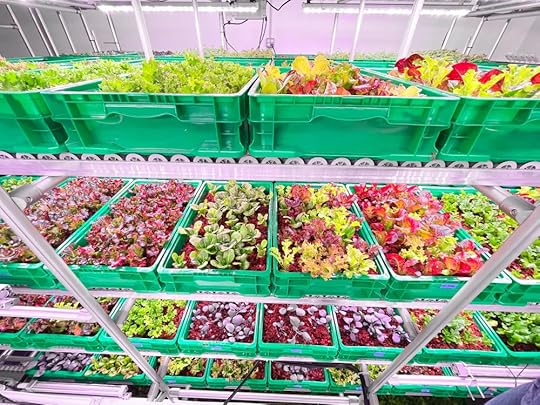
With office usage hovering near 50 percent of pre-pandemic levels, cities are putting the underutilized space to new use growing food
The LR Zone
In an old paper company and warehouse building, machines are whirring again. But instead of reams of paper pressed and cut, this warehouse is home to Area 2 Farms, which now pumps out greens, herbs and root vegetables. There’s even a weekly CSA serving customers year round, all in an effort to bring locally grown food to the Washington, D.C. area. Really local. “When was the last time you picked up a strawberry and could confidently say you knew the farmer’s name?” asks Jackie Potter.
Potter, along with Tyler Baras, helped co-found the farm in Arlington, Virginia, where office vacancy rates reached 23.7 percent in the first quarter of 2023.
Although the Covid-19 pandemic drove workers out of their offices over three years ago, many office buildings still remain deserted. According to data gathered in 10 major cities, office usage rates just crossed 50 percent of pre-pandemic levels in late January, and these numbers seem to be stalling only a few months later. Nearly 20 percent of office space is empty across the United States, and some projections suggest that more than 300 million square feet of U.S. office space could be obsolete by 2030. The pandemic has shown that people are capable (and in some cases, in favor) of working in a remote setting.
With many folks comfortably working from home offices, many downtown high-rises serve as a looming frustration to landlords but also to local restaurants and small businesses that rely on office commuters to sustain business. So, many municipalities are trying to fill those spaces back up. In New York, city officials are transforming empty office buildings into apartments around parts of Midtown. Many other regions are also exploring this idea, including Washington, Los Angeles, Milwaukee, Chicago and Philadelphia. Although modifying an existing building is less expensive than rebuilding, turning offices into residential space can be costly, as most office spaces are laid out differently from residential buildings. But there are other options for these empty offices—such as farms.

Area 2 Farms pumps out greens, herbs and root vegetables. Area 2 Farms
Baras took this idea to heart when designing Area 2’s growing apparatus, Silo. Silo is a multilevel conveyor belt system that moves vertically throughout the day to replicate a plant’s natural circadian rhythm. Since the system moves automatically, Silo’s conveyor belt cuts down on some of the backbreaking work that accompanies traditional vertical farming methods, such as climbing up and down ladders. Also, Silo requires no modifications to the existing building before installation. Area 2 Farms plans on building a model of Silo in Union Station in Washington later this year to showcase its growing technology and advocate for local food systems.
Just as cities have changed drastically over the past few years, Potter and Baras recognized that our modern food system is changing, too, and farmers must be ready to adapt. “The idea we have of what farms used to be is not what farms are today. There is no picturesque, red-barn farm anymore,” says Potter.
In Calgary, Alberta, AgriPlay Ventures transformed part of underutilized office space in Calgary Tower Center into one of Canada’s largest indoor urban farms earlier this year.
Dan Houston, president of AgriPlay, who has worked in the business for two decades, had long thought that vertical farming and office buildings were a natural match. “I didn’t know why [farms] weren’t in office buildings already. They should be, because the office market is so bad and it’s only getting worse,” says Houston. In addition to a struggling commercial real estate sector, Alberta is reported to have the highest rate of food insecurity among Canadian provinces; approximately one in five Alberta households is food insecure. The farm at Calgary Tower produces tomatoes, strawberries, cucumbers, greens and much more for the local community, with some crops offering 30 harvests a year. Although only one floor of the approximately 262,500-square-foot building is currently being utilized for food production, AgriPlay wants to expand to another two floors in the coming months and years. Currently, AgriPlay Farms is negotiating offers on more than one million square feet of office space in Calgary.
“The Calgary Tower was going to be a showcase of how to grow inside of the space of a building. Since then, we’ve already built a much superior product. We’re getting ready to extend into the rest of the building and the other spaces that we occupy,” says Houston.
According to Houston, office spaces already provide an ideal environment for growing food, since they are already air conditioned, heated and well ventilated. Not many modifications have to be made to the buildings themselves. Similar to Silo, AgriPlay’s growing system can also be easily installed in a wide variety of buildings and settings, which makes it an appealing prospect to potential landlords.
AgriPlay provides hardware that uses artificial intelligence to convert and install custom, plug-and-play modular growth systems. According to Houston, its scalable installation model was designed specifically to fit into existing office real estate spaces, and it doesn’t require prior knowledge of farming.
“Our system tells people what to do. I don’t need to know anything about growing strawberries. I just tell the system I’m growing strawberries and it sets the work up for me,” says Houston.
In time, AgriPlay hopes to become the technology provider that allows community stakeholders to market and grow in their own communities.
 A group takes a tour of Area 2 Farms. Area 2 Farms
A group takes a tour of Area 2 Farms. Area 2 FarmsWhen executed correctly, vertical farming can yield as much produce as traditional farming methods in urban areas and smaller spaces. Additionally, vertical farmers gain the added benefit of consistent, year-round production without the uncertainties of climate or pests, all while utilizing 90 percent less energy and 98 percent less water than a traditional farm. Although it can’t be a replacement for more traditional methods, vertical farming provides fresh produce in areas that have little food production or access to healthy foods.
“It seems like we’ve hit a sweet spot where the entire world needs food security; it’s now a national security interest for most countries. At the same time, commercial real estate is imploding,” says Houston. “You put those two together, and you’ve got a fast, easy conversion method to onshore your food production and solve your commercial vacancy issues.”
Potter agrees, noting that utilizing empty office space for farming could reshape urban centers as we know them now.
“Cities are changing every day,” says Potter. “There’s a really great economic opportunity as well. Our farms create new green jobs, they beautify spaces and provide fresh food to local communities. That’s something that’s really precious.”
Coconut Oil Superior to Drugs in Destroying Pathogens
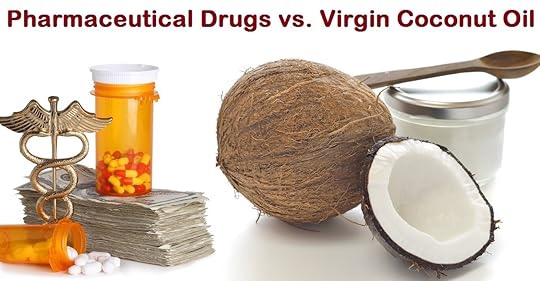
by Brian Shilhavy
Editor, Health Impact News
The U.S. Government’s official position on coconut oil today continues to be that it is dangerous for your health, and that you should either avoid it altogether, or only consume very modest amounts.
The reason that has been given for this official position for over four decades now, is because it is primarily a “saturated fat” which they want you to believe leads to high levels of cholesterol and heart disease.
But nothing could be further from the truth, as the whole “lipid theory” of heart disease has been completely debunked, along with U.S. Government dietary advice that condemns saturated fats, which are found primarily in animal fats and dairy, as well as in some vegetable sources such as coconuts and palm nuts.
Saturated fats have been part of the human food chain for thousands of years. Our ancestors here in the U.S. settled in this country consuming primarily these saturated fats, such as lard, beef tallow, and of course, butter.
Tropical countries where coconut palms grow have consumed the tropical oils of coconut and palm fruit oils for thousands of years.
And prior to the industrial age that began after World War II, heart disease was not a major cause of death.
The technological advances that came out of WW II gave us the ability to extract oils from plant sources that were never part of the human food chain, and that included primarily the expeller-pressed seed oils from corn and soy, which today are the main GMO crops that are sprayed heavily with glyphosate and a whole host of other herbicides and pesticides.
These polyunsaturated oils prior to the industrial age were only consumed as whole foods in nuts and seeds, since the technology did not exist prior to that to extract them with simpler technology, and these polyunsaturated oils have to be heavily refined just to make them shelf stable.
I have made it a personal standard for myself and my family over the years to NOT consume any dietary oil or fat that has not been in the food chain for at least 1000 years, which includes olive oil, sesame seed oil, black cumin seed oil, coconut oil, and palm oil from plant sources, and lard, beef tallow and butter from animal sources.
When it comes to coconut oil, the real reason why the U.S. Government attacks it is because they are protecting their lucrative drug industry, because the peer-reviewed medical literature shows that coconut oil can cure multiple diseases that Big Pharma wants to sell you drugs to “cure” instead. (But their drugs don’t “cure” because curing sickness is a terrible business model and eliminates their repeat customers.)
At the top of this list of drugs is antibiotics, and the peer-reviewed medical literature has shown that the fatty acids in coconut oil destroy pathogens since at least the 1960s.
And those studies continue to be published today, although usually outside the U.S. One of the latest ones to be published is in the journal Advances in experimental medicine and biology this month (August, 2023), titled: Antimicrobial Potential of Cocos nucifera (Coconut) Oil on Bacterial Isolates.
Abstract
Lauric Acid – Used to Destroy Pathogens for Decades
This study investigates the in vitro antibacterial activity of coconut oil on selected clinical and pure bacterial isolates. Clinical samples were isolated from the people of Ras Al Khaimah, United Arab Emirates.
Biochemical examination of the microorganisms was done according to standard methods. Pure bacterial cultures were provided from LTA srl Italia. In this research work, an effort has been made to highlight the valuable properties of Cocos nucifera oil, in order to rationalize the use of coconut oil against bacteria.
Experiments were performed by agar well diffusion method. Ciprofloxacin was used as a standard antibiotic. The assay of antibacterial activity of clinical isolate of Streptococcus species showed the highest susceptibility to coconut oil while Escherichia coli had the least.
This study endorses the use of coconut oil as therapeutic agent since it contains lauric acid which is bactericidal. The utilization of coconut oil should be promoted as a functional food and the use of coconut seed flesh in our diets should be encouraged for health-supporting functions. Further studies should be done on the oil and its derivatives both in vitro and in vivo to unveil their mechanism of action. (Source. Emphasis mine.)
Coconut oil is composed of primarily “medium chain fatty acids,” or “medium chain triglycerides,” which is just another way of saying the same thing, and is often abbreviated as “MCTs”.
The star fatty acid in coconut oil is lauric acid, which is usually about 50% of the composition of coconut oil.
It has been used as an anti-bacterial for decades, including usage in food preservatives.
Coconut oil is nature’s most abundant source of lauric acid. The next closest source is human breast milk, which comes in at a distant second at around 6% lauric acid.
Lauric acid is primarily what makes coconut oil a “saturated” fat, which the U.S. Government wants to make you believe is unhealthy. But the truth is that saturated fats are healthy and disease-fighting, which is obviously why God included it in human breast milk for babies.
Yes, babies who are fed their mother’s breast milk until they are weaned, are being fed a high-saturated fat diet, and starting their life out by shaking their tiny fist in the face of the U.S. Government tyrants, who want to make them into pin cushions by vaccinating them from the time they are born.
While we cannot continue drinking our mother’s breast milk for the rest of our lives, God has given us coconut oil which is even higher in lauric acid.
If you search for “lauric acid” on the Health Impact News network, you will get over 100 results, with articles such as these:
Study: Coconut Oil’s Lauric Acid Reduces High Blood PressureStudy: Lauric Acid from Coconut Oil Inhibits Cancer Cell Growth Without Affecting Healthy CellsNew Research on Coconut Oil Focuses on Replacing Antibiotics to Combat Antibiotic-resistant PathogensStudy: Coconut Oil Fatty Acids have Bactericidal and Anti-inflammatory Activities Against AcneStudy: Lauric Acid from Coconut Oil Proves a Promising Weapon in the Fight Against Antibiotic Resistant Infection with Severe Burns… and dozens of others.
You can keep up with the research on coconut oil on our peer-reviewed research page at CoconutOil.com, which I update regularly as I have done for over 2 decades now.
Also, please do NOT confuse what is sold in the market as “MCT Oil” as coconut oil. MCT oil is a byproduct of coconut oil, and is only the fatty chain acids that are left over once lauric acid is extracted.
What Type of Coconut Oil is Best? How to Choose a Coconut Oil
[…]
21th Century India, Pakistan and Bangladesh

Pakistan’s caretaker prime minister Anwar Ul Haq Kaka (Balochistan Awami Party)
Episode 36 South Asia Into the 21st Century
A History of India
Michael Fisher (2016)
Film Review
In this concluding lecture, Fisher makes no mention of BRICS, which would seem a major omission in light of current world events.
He outlines three specific problems facing all three South Asian countries in the 21st century:
a trend towards evicting indigenous forest people from their traditional homelands*evictions of farmers, pastoralists and indigenous people for dam construction and other development projects.rapid population growth – as of 2016 South Asia hosted 20% of the global population on 3% of its land mass and one-third of the world’s poor.To their advantage, all three countries have a huge youth labor pool approaching “peak productivity” (ie willing to work for subminimum wage) . This means transnational corporations are greedily shifting manufacturing to India, Pakistan and Bangladesh from China and South East Asia where wages are rising.
All these trends contribute toward the growth of South Asian megacities:
Karachi pop 24,000,000Mumbai pop 12,470,447Dakka pop 15,876,105Delhi 16,814,838Gender disparity is rife in all three countries although all three have had women prime ministers.
All three countries have coastal cities threatened by rising sea levels. The most dire prediction predict a loss (via flooding) of 15% of South Asia’s land mass (mostly in Bangladesh). There are also predictions global warming will melt Himalayan glaciers and disrupt the seasonal monsoons essential to agriculture. South Asia also experiences a disproportionate number of earthquakes and tsunamis.
Likewise all three demand that CO2 reduction mandates not restrict their access to fossil fuels, which they view as essential to the industrialization needed for improving their standard of living.
Recent political highlights:
India
The Hindu nationalist party BJP has been in power continuously since current prime minister Narendra Modi was elected in 2014. The BJP is a more right-wing than the Congress party, as well as less secular. They have repealed a number of environmental protection enacted by Congress governments, owing to their view they were limiting economic development. Approximately 20% of India’s residents are non-Hindu (mainly Sikhs, Christians, Muslims, Buddhists and Jews).
Pakistan
Only 3% of Pakistanis are non-Muslim, and most residents are Sunni Muslim. Since the coup d’etat removing Imran Khan last year,**Muslim League leader Shehbaz Sharif (brother of Nawaz Sharif) was elected to complete Imran Khan’s term. After the national assembly was dissolved on August 14 2023 (having completed its five-year term), Anwar Ul Haq Kaka was appointed caretaker prime minister until new elections can be called. He’s a member of the Balochistan Awami Party.
Fisher highlights two Pakistani non-governmental organizations assisting poor Pakistani women access microcredit, which he feels have been significant in improving Pakistan’s life expectancy, infant mortality and literacy. The first is the Grameen Bank, founder by Muhammad Yunus in 1976, and BRAC, founded by Sir Frale Hasan Abed in 1972. The latter also helps poor families access education and health care.
*Fisher neglects to mention the growing proportion of indigenous evictions that occur for “environmental” reasons. See http://www.forestpeoples.org/sites/fpp/files/news/2016/08/160831_publication_Human%20Rights%20project_def.pdf
**See Hidden History of the Coup Against Imran Khan
Film can be viewed free with a library card on Kanopy.
https://www.kanopy.com/en/pukeariki/watch/video/366254/366243
August 30, 2023
Screen Time for Babies: Unsafe at Any Dose

A Japanese study reported that the more time per day 1-year-olds spent in front of screens, the worse their performance on standard developmental evaluations at ages 2 and 4. Delays in acquiring communication and problem-solving skills were the most prevalent and enduring effects.
One-year-olds who log more screen time are at higher risk for developmental delays at ages 2 and 4 — and the greater the screen time, the more serious and prolonged the deficits, according to a study published this month in JAMA Pediatrics.The most pronounced effects involved delays in communication and problem-solving. Other measures of childhood development lagged at the two-year follow-up but vanished by age 4.
However, the researchers cited a 2020 study that also associated high device use with communication deficits — but conversely, found “better-quality screen use” involving educational content was linked to “stronger child language skills.”
Parents and babies co-viewing content, and a later onset of screen use, also seemed to be beneficial, according to the 2020 study.
The multi-university research team behind the JAMA Pediatrics study, led by first author Ippei Takahashi at the Graduate School of Medicine, Tohoku University in Sendai, Japan, defined screen time as the number of hours per day 1-year-olds spent watching television, playing video games and using mobile phones, tablets or other electronic devices.
How the study was designed
Between July 2013 and March 2017, the Tohoku Medical Megabank Project Birth and Three-Generation Cohort Study recruited 7,097 mother-child pairs at 50 obstetric clinics and hospitals in the Miyagi and Iwate prefectures in Japan. Fifty-two percent of the subjects were boys.
Researchers grouped subjects according to one of four screen time exposure categories: less than one hour per day (48.5% of subjects), between one and two hours (29.5%), between two and four hours (17.9%) and four hours or more (4.1%).
The four exposure groups were matched for sex, maternal age and education, number of siblings, household income and demographics, and whether the mother had experienced postpartum depression.
Investigators applied the Japanese version of the Ages & Stages Questionnaires (3rd edition) to evaluate five developmental areas: communication, gross and fine motor skills, problem-solving and socialization.
Scoring in each area ranged from 0-60 points, with developmental delay defined as a score that was less than two standard deviations below the mean score. This high threshold means that to be counted, a value had to be lower than 95% of all other results.
What the researchers found
The researchers found that, generally, the more screen exposure at age 1, the greater the later deficit and the longer it persisted.
However, not all measures were negatively affected and not all deficits at age 2 were evident by age 4.
Table 1 summarizes Takahashi’s results.
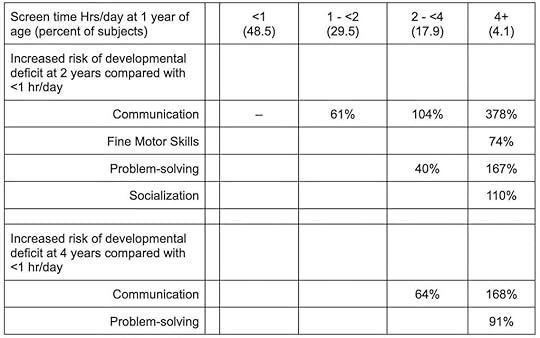 Table 1. Increase, in percent, in the number of children failing to reach development milestones relative to the lowest-exposure group, for followups at age 2 (top rows) and age 4 (bottom rows).
Table 1. Increase, in percent, in the number of children failing to reach development milestones relative to the lowest-exposure group, for followups at age 2 (top rows) and age 4 (bottom rows).For purposes of analysis, values from the three highest-exposure groups were compared to the result from the lowest-exposure babies and expressed as a percentage above that number.
For example in the table above, the value for “communication skills” in year 2 for the 1- to 2-hour group is 61% higher than the number for the <1 hour group. That means that, compared to the group with the lowest exposure, 61% more children in the second-lowest exposure group failed to meet a development milestone.
The most notable deficits arose for communication skills, which were evident in all groups at the two-year point and persisted at the four-year mark for the two highest-exposure groups.
Problem-solving deficits were observed for higher-exposure children as well but waned over time. Social development fell at two years for the highest-exposure group but disappeared by age 4.
The take-home lesson is that screen time affects some areas of childhood development but not others, and that not all associations persist.
For example, Takahashi found that the highest screen exposure times were associated with deficits in fine motor and social skills at age 2, but not at age 4. He proposed that these deficits themselves may be the reason children spent more time in front of screens, and not the other way around.
Device use guidelines
In 2016 the American Academy of Pediatrics (AAP) issued device usage guidelines for physicians, families and media companies.
The AAP recommended doctors initiate a conversation with families on device usage early, help them develop a media use plan, educate them about early brain development and the benefits of hands-on, unstructured and social play, and discourage any device exposure for children younger than 18 months.
For parents interested in introducing 18- to 24-month-olds to digital media, the physician group encouraged them to choose high-quality programming and personally oversee its use, advising that “Letting children use media by themselves should be avoided.”
Older children are OK with up to one hour of high-quality programming per day, but screens should be avoided during meals and right before bedtime. Parents should disallow fast-paced programs, apps with a lot of distracting signs or sounds and any violent content.
The AAP also cautioned parents to avoid using devices as babysitters:
“Although there are intermittent times (e.g., medical procedures, airplane flights) when media is useful as a soothing strategy, there is concern that using media as strategy to calm could lead to problems with limit setting or the inability of children to develop their own emotion regulation.”
In addition, it urged media developers to:
Design programming appropriate for child development.Promote parent-child interaction and real-world skills.Eliminate commercial and “unhealthy” messaging.Create programs that do not automatically advance to the next episode or unit.Cease making apps for children younger than 18 months until evidence of benefit is demonstrated.Despite pervasive device use among young children, very little research has addressed how screen time might affect a child’s development, according to Takahashi.
Most studies focused on a limited number of developmental milestones or did not directly link screen exposure at one specific point in time with an effect at another point.
[…]
Via https://childrenshealthdefense.org/defender/screen-time-babies-developmental-delays/
Food Isn’t What It Used to Be – And Neither is Public Health
 By Dr. Joseph Mercola
By Dr. Joseph Mercola Industrial agriculture with its genetically engineered crops, pesticides and soil destruction has led to a decline in the nutritional value of food — and nutrient-deficient food is linked to a higher incidence of viral illness, gluten sensitivity, autism, dementia, depression and more.
Story at a glance:Multiple challenges contribute to the declining nutritional value researchers find in plants, grasses and grains, including monocropping, genetically modified crops, high-yield practices and the destruction of soil health.As nutrient density falls so does public health. The U.S. spends $4.3 trillion on health care each year, which is more than any other nation. Deficiencies are linked to a higher incidence of viral illness, gluten sensitivity, autism, dementia, depression and more.The U.S. government admits poor eating has led to nearly half of all Americans living with at least one chronic disease. However, while junk and snack food companies seek to garner consumers interested in organic production, it’s essential to note that organic ingredients can’t make junk food healthy.Biodynamic and regenerative farming choices offer hope after chemical-based agriculture has destroyed rural economies, raised air and water pollution, destroyed pollinators and biodiversity and increased soil erosion.One of the largest studies to draw attention to the declining nutrient value in fruits and vegetables was published in 2004 in the Journal of the American College of Nutrition.
The researchers used data gathered from 1950 to 1999 and found that out of 43 foods evaluated, there were reliable declines in six nutrients. Those nutrients include protein, riboflavin, vitamin C, calcium, iron and phosphorus.
The researchers evaluated data on seven other nutrients for which they found no statistically reliable changes.
The team concluded that the declines were easily explained by changes in cultivated varieties and these declines may be a trade-off between cultivation to raise yield and an impact on nutrient content.
Your body depends on essential nutrients for growth and development, and to maintain optimal health. When you experience deficiencies, it can have a significant impact on immunity, wound healing, bone health and much more.
Your body uses protein to build muscles, manufacture hormones and create antibodies.
Vitamin C is an integral part of your immune system and riboflavin, which is one of the eight B vitamins, helps convert food into energy.
Deficiencies in any of these nutrients have a fundamental impact on overall health and wellness. Nutrient-dense foods provide your body with more of what it needs to support good health.
Nutrient density considers both macronutrients, such as protein, fats and carbohydrates and micronutrients, which include vitamins and minerals necessary for normal physiological functioning.
Declining nutritional values affect produce and meat
Research within the last five years has also demonstrated a decline in nutrients, including iron content in vegetables grown in Australia.
The researchers looked at the iron content of vegetables and legumes and noted a decrease of 30% to 50% in sweet corn, redskin potatoes, cauliflower and green beans and pronounced reductions in legumes.
The researchers warned that as plant-based diets become more popular, monitoring nutrient composition is “strongly recommended.”
Another study noted a 23% decline in protein content in wheat and notable reductions in manganese, zinc, magnesium and iron. The impact of declining nutrient density in produce and grain affects not only vegetarians but also meat eaters.
Livestock is fed less nutritious grasses and grains, which in turn has an impact on many animal-derived products that are not produced on biodynamic or regenerative farms, including meat, dairy and eggs.
These studies demonstrate that it turns out you can simultaneously gain weight and be starved of vital nutrients essential to good health. Donald R. Davis of the University of Texas at Austin was the lead author of the 2004 study and worked on subsequent papers on the same subject.
[…]
In addition to declining nutrient value, world crises are making a bad problem worse. Ukraine has been called “the breadbasket” of Europe as the country is responsible for producing and exporting roughly 12% of all food calories traded on the international market.
Russia is also a major exporter, and the two countries together account for nearly 30% of global wheat exports, nearly 20% of the world’s corn and more than 80% of the sunflower oil.
The U.S. Department of Agriculture projected that wheat exports from Russia and Ukraine would be down by more than 7 million metric tons in 2022.
According to a report in January, the exports from Ukraine had reached 23.6 million metric tons of grain, which had fallen from 33.5 million recorded at the same time in the previous season.
Ukraine’s government reported that the grain harvest would reach 51 million metric tons, a decline from the record 86 million in 2021 because of a loss of land and lower yields.
By July 2022, the United Nations had brokered the Black Sea Grain Initiative between Russia and Ukraine. This allowed Ukraine to export grain through the Black Sea from ports that had been blocked since mid-February.
While the initiative helped facilitate exports from Ukraine, price volatility for wheat had reached its highest level in more than 10 years. International markets adjusted and adapted, resulting in higher-priced foods that nearly everyone has experienced at the grocery store.
According to data from the Inter-American Institute for Cooperation on Agriculture, the change in wheat exports from 2021 to 2022 dropped by 5.3 million metric tons in Ukraine, 8.5 million metric tons in Argentina and rose by 10.5 million metric tons in Russia.
Perfect storm threatens public health
As crop nutrient density declines, so does public health.
Nutritional deficiencies are linked to a higher incidence of viral illness, gluten sensitivity, autism, dementia and depression to name a few. Multiple challenges have arisen that appear to be contributing to this issue of food insecurity.
As Davis noted, high-yield plants have resulted in lower nutrient density. National Geographic explains that crops with higher yields are grown in fields with finite resources.
This means that the nutrients must be distributed across a greater volume of produce, which in effect, dilutes the nutrient value. Another challenge to growing nutrient-dense crops is soil damage from high-yield practices, such as tilling, monocropping and GMO seeds.
Most crops benefit from partnerships with soil fungi as they improve the plant’s ability to absorb nutrients and water. Yet these high-yield practices hurt beneficial fungal growth.
Growing just one crop species, also called monocropping or monocultures, increases the farmers’ efficiency in the short term but it also increases the risk of disease and pests and leads to soil exhaustion.
Genetically modified crops gained widespread commercial use by 1996 and today, most corn, soybean, cotton and canola are genetically modified.
While some continue to promote genetically modified seeds and the subsequent high-dose herbicides and pesticides used to control weeds and pests, further study reveals how this damages soil microbes and subsequently our food supply.
Glyphosate is one of the most widely applied broad-spectrum herbicides in agriculture.
However, as the Soil Association notes, glyphosate negatively affects soil bacteria and harms beneficial fungi that live near plant roots.
In past years, glyphosate has increased the severity of crop diseases, possibly by altering the balance of soil microbes. It also has had a negative impact on the activity of several earthworm species.
Another factor that plays a role in reducing crop nutrient density is the use of nitrogen fertilizers.
These fertilizers consistently favor the growth of pathogenic fungi while harming beneficial fungi necessary for strong plant growth. Yet corporate farmers have grown reliant on nitrogen and phosphorus fertilizers.
The combination of the breakdown in logistics during the pandemic and the later conflict in Russia and Ukraine led experts to predict fertilizer prices could double in the following growing seasons.
Nearly 40% of the global export of potash, a key fertilizer ingredient, and 48% of ammonium nitrate is exported from Russia.
Prices rose in 2022 but dropped in the first quarter of 2023. However, experts believe this trend may not continue and likely is giving farmers false hope, as experts anticipate price reductions could be temporary.
Improving soil health can’t make junk food healthy
As more consumers are looking for organic products, more manufacturers of snacks and junk foods are seeking to capitalize on the trend.
For example, Annie’s, a division of General Mills, advertises “advancing regenerative farming practices” in their limited-edition Organic Mac & Cheese and Organic Bunny Grahams.
However, there is a range of practices that could be referred to as regenerative, even though they’re only slightly different from conventional, chemical farming.
The fact that General Mills is partnering with Ben & Jerry’s to promote their brands with regenerative agriculture for highly processed junk food like mac and cheese, cookies and concentrated animal feeding operation ice cream is another strange path forward.
While it will take farmers, businesses and consumers to advance regenerative practices, you have to be skeptical of this odd alliance of junk food products to promote regenerative agriculture.
The falling nutrient density in produce is especially concerning if consumers follow manufacturers’ push for a primarily plant-based diet.
Much, but not all, of the fake food promoted by globalists is plant-based. The rest is a combination of lab-grown slurry altered using advanced technology to increase consumer appeal.
The underlying truth is that improving soil health and raising plants’ nutrient density cannot make junk food healthy. Instead, most Americans need to start eating real food to save the planet and improve their health.
Eating organically produced foods is important, but when these are processed foods, it doesn’t matter if they’re organic and regeneratively grown, your health still suffers from nutritional imbalances.
[…]
Via https://childrenshealthdefense.org/defender/nutritional-value-food-public-health-cola/
Organized Crime in Charge of EU Carbon Trade
Organized Crime in Charge of EU Carbon Trade, Europol Says
Ersjdamoo’s Blog
“In the US, the derivatives market regulator has issued a whistleblower alert relating to fraud and misconduct in carbon markets and has created a new environmental fraud taskforce.” [1]
A study released last week could portend billions of dollars in losses for speculators in carbon offsets. Many of the carbon credits purchased by polluting corporations amount to little more than “hot air”. [2]
Carbon credits are essentially predicting whether someone will chop down a tree, and selling that prediction, said one study author. [2] A carbon credit or offset credit is a transferrable financial instrument (i.e. a derivative of an underlying commodity) certified by governments or independent certification bodies to represent an emission reduction that can then be bought or sold. [3] Some banks have huge derivative holdings. For example, Goldman Sachs Bank USA, holds more than $53 trillion in derivatives. [4]
Data on groundwater levels across the U.S., compiled by The New York Times, shows that over the past 40 years groundwater levels at most of the sites surveyed have declined. “At 11 percent of the sites, levels last year fell to their lowest level on record.” NYT is alarmed. “The U.S., in other words, is taking water out of the ground more quickly than nature is replenishing it.” [5]
——- Sources ——-
[1] “Beats Were Beaten Down”, Ersjdamoo’s Blog, August 29, 2023. https://ersjdamoo.wordpress.com/2023/08/29/beats-were-beaten-down/
[2] “Study Finds Carbon Offset Schemes ‘Significantly Overestimating’ Deforestation Claims”, Common Dreams. https://www.commondreams.org/news/carbon-offset-deforestation
[3] “Carbon offsets and credits”, Wikipedia. Accessed August 29, 2023. https://en.wikipedia.org/wiki/Carbon_offsets_and_credits
[4] “Mannarino: Major Banks in Big Trouble”, Ersjdamoo’s Blog, June 5, 2023. https://ersjdamoo.wordpress.com/2023/06/05/mannarino-major-banks-in-big-trouble/
[5] “The Morning: Uncharted waters”, New York Times mass email, August 29, 2023.
[…]
Via https://ersjdamoo.wordpress.com/2023/08/30/carbon-credits-questioned/
The Most Revolutionary Act
- Stuart Jeanne Bramhall's profile
- 11 followers



